|
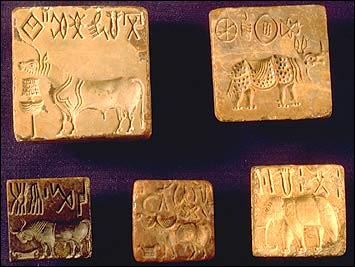
 Easter
Island - Indus Valley Scripts: Easter
Island - Indus Valley Scripts:
Rongorongo is Oceania's only
indigenous script. It is found in one location only
- In the centre of the Pacific Ocean, over a thousand miles from
any continent. We now know that the first migrations to Easter
Island were deliberate, because they involved taking the people,
plants and animals needed to establish sustainable colonies
(6). The script was first identified in
1864, and any suggestions that it originated after European
contact are rejected on the basis that at least two of the
Rongorongo tablets are dated to before their arrival
(1). So
the big question remains... where did it come from?
(Rongorongo
- Corpus of Texts)
(Examples
of Indus Valley Script - I.V.S)
(Comparison
Chart of Indus Valley Script and
Rongorongo Characters).
The Origin of
Rongorongo:
Tradition says the the first king, Hoatu-matua, brought with him sixty-seven
wooden tablets. Later on, the number of tablets is supposed to have been much
larger. From one of the last chiefs, Ngaara, it is told that he had several
hundreds. Radiocarbon dating has shown that the dates for the decline of tree
pollen, and therefore the first settlement, began around AD 900, or possibly a
couple of centuries earlier (4). The erection of statues was in full swing by
AD 1,200 and the collapse came around AD 1,500. Natives tell that the original
glyphs brought by the first immigrants, had been
written on paper made from the banana plant; but later on, for the better
preservation of the documents they were written on wood. According to Eyraud
and Geiseler the glyphs were engraved with a piece of obsidian; but
Routledge
and Metraux mention catfish teeth as instruments for engraving.
(2)
The
Austronesian Polynesians,
who first settled the island, are likely to have arrived from the
Marquesas Islands from the west.
(3)
The island at one time supported a
relatively advanced and complex civilization. We now know that the
Between about 3,000 and 1,000 BC speakers of Austronesian
languages spread through island South-East Asia � almost
certainly starting out from
Taiwan
In the mid-2nd millennium BC the distinctive Lapita culture
appeared suddenly in north-west Melanesia. Within a mere three
or four centuries between about 1300 and 900 BC, the Lapita
culture spread 6000 km further to the east from the Bismarck
Archipelago, until it reached as far as Tonga
and
Samoa.
In this region, the distinctive Polynesian culture developed.
The pattern of settlement that is believed to have occurred is
that the Polynesians spread out from the Samoan Islands into
eastern Polynesia - the Marquesas, the Society Islands, the
Hawaiian Islands and Easter Island.
(5)
Although Easter Island was first officially discovered by
Europeans in 1722, it is clear that the Pacific was being
successfully navigated for thousands of years before their
arrival.
The first
record of Rongorongo was by Eug�ne Eyraud in 1864. He remained
on Easter Island for nine months, evangelizing the inhabitants.
He wrote an account of his stay in which he reports his
discovery of the tablets that year:
'In
every hut one finds wooden tablets or sticks covered in
several sorts of hieroglyphic characters: They are
depictions of animals unknown on the island, which the
natives draw with sharp stones. Each figure has its own
name; but the scant attention they pay to these tablets
leads me to think that these characters, remnants of
some primitive writing, are now for them a habitual
practice which they keep without seeking its meaning'
�
Eyraud 1866:71
In 1868 the Bishop of Tahiti received a gift from the recent Catholic converts
of Easter Island. It was a long cord of human hair, a fishing line perhaps,
wound around a small wooden board covered in hieroglyphic writing. Stunned at
the discovery, he wrote to Father Hippolyte Roussel on Easter Island to collect
all the tablets and to find natives capable of translating them. But Roussel
could only recover a few, and the islanders could not agree on how to read them.
What happened to the hundreds of tablets seen only four years
before is a matter of conjecture. Steven Chauvet reported the
following:
'The
Bishop questioned the Rapanui wise man, Ouroupano
Hinapote, the son of the wise man Tekaki [who said that]
he, himself, had begun the requisite studies and knew
how to carve the characters with a small shark's tooth.
He said that there was nobody left on the island who
knew how to read the characters since the Peruvians had
brought about the deaths of all the wise men and, thus,
the pieces of wood were no longer of any interest to the
natives who burned them as firewood or wound their
fishing lines around them'... ...'A. Pinart also saw some
in 1877. He was not able to acquire these tablets
because the natives were using them as reels for their
fishing lines'.

Today, only 26
examples of Rongorongo text remain (with 3 disputed), each with letter codes
inscribed on wooden objects, containing between 2 and 2320
simple and compound glyphs, with over 15,000
in all. Two of the tablets, C and S (above), have a
documented pre-missionary provenance, though others may be as
old or older. (1)
(View
Surviving Rongorongo Corpus Here)
The Loss of Rongorongo:
In December
1862, Peruvian slave raiders struck Easter Island. Violent
abductions continued for several months, resulting in the
capturing or killing around 1500 men and women, about half of
the island's population. The art of writing was effectively extinguished
at this time when the Peruvian slave-raiders carried
off all professionals of writing in 1862
(3).
The subsequent
disappearance of the old wooden tablets is probably due to their
sacred character as the natives hid them from the European
immigrants, presumably because the missionaries considered the ceremonial
documents as idolatrous objects. The natives repeatedly asserted
that the missionaries had prohibited them from reading the
tablets, and even had induced them to burn these objects as
devil's work. The Swede De Greno, who arrived about 1870 at
Easter island, said the following:
�...soon after the Catholic Mission was established on the
Island, the missionaries persuaded many of the people to
consume by fire all the blocks (tablets) in their
possession, telling them that they were but heathen
records and that the possession of them would have a
tendency to attach them to their heathenism and prevent
their thorough conversion to the new religion and the
consequent saving of their souls..�.
Also Mrs.
Routledge, the renowned explorer of Easter island, was told by a
native that he possessed a great number of tablets, all of which
he had thrown away on the advice of the missionaries, and
afterwards another man had built a boat of them.
(2)
Indus Valley and Easter
Island (Similarities in Script).
In 1932, Wilhelm de Hevesy
was the first academic to suggest a link between Rongorongo and the Indus script of the Indus Valley Civilization in
India, claiming that as many as forty Rongorongo symbols had a
correlating symbol in the script from India. For a while, the idea
was entertained and debated until radiocarbon dating of the
Indus Valley culture was placed between c. 3,300 - 1,900 BC
(7), a finding which officially
separated the two cultures by over 2,000 years. Recent research
however, has opened the debate again as the finding of Indus Valley
DNA in Australian Aborigines suggest a contact between the two
cultures c. 2,000 BC.
'A recent
study by Irina Pugach of
the Max Planck Institute for Evolutionary Anthropology, in Leipzig,
and her colleagues, which has just been published in the
Proceedings of the National Academy of Sciences,
has apparently resolved the matter. About 4,000 years before
Europeans arrived, it seems that a group of Indian adventurers
(from the same time as the great Indus Valley Civilisation)
chose to call the place home. Unlike their European successors,
these earlier settlers were assimilated by the locals. And they
brought with them both technological improvements and one of
Australia�s most iconic animals, the Dingo'.
(8)
Perhaps no
coincidence that studies in language evolution have shown that the
navigation and settlement of the Pacific began at the same time and
in the same region, continuing from west to east finally reaching
Easter Island approximately c. 1,000 BC.
'The
settlement of the Pacific proceeded in a series of expansion
pulses and settlement pauses. The Austronesians arose in Taiwan
around 5,200 years ago. Before entering the Philippines, they
paused for around a thousand years, and then spread rapidly
across the 7,000 km from the Philippines to Polynesia in less
than one thousand years. After settling Fiji, Samoa and Tonga,
the Austronesians paused again for another thousand years,
before finally spreading further into Polynesia eventually
reaching as far as New Zealand, Hawaii and Easter Island'.
(9)
The continued
navigation and colonisation of the Pacific Islands from this time
onwards offers the possibility of a continuation of the traditions
of a 'sacred' script. Egyptian Hieroglyphs, Chinese logograms and
Sumerian cuneiform are all testimony to the longevity of language.
In ancient times, many scripts were considered sacred such as the
Hebraic Torah still is today. These 'sacred' texts were transferred
meticulously without deviation for millennia. This theory is
supported by the discovery of repeated script on more than one of
the few surviving Rongorongo tablets.
In addition, recent
epigraphic research have revealed both further similarities between
the two scripts but also, and more significantly, that similarities
between groupings of characters can be found in both scripts. A
finding which cannot be ignored or considered simply a further
coincidence. We are left with a mystery which however unlikely,
appears to show a thread of connection between the two cultures.

Two Indus Valley seals with corresponding Rapa Nui
symbols to illustrate the similarity between characters.
(Image Credits:
Rongorongo and the Indus Script)
(Comparison
Chart of Similar Symbols From I.V.S and Rongorongo Script)
|
Arguments
Against a Connection: |
The main objections
to any connection between the two scripts remain as follows:
1). Easter Island is as far away from the
Indus Valley Culture as it can possibly be.
Response:
As noted above, recent research has shown that the indigenous
population of Australia contains the Indus Valley genome which
is estimated to have arrived c. 3,000 BC. This is proof that the
Indus Valley Dravidians were proficient both at navigation and were
exploring the edges of the Pacific ocean at the very time
that linguistic studies have shown that an Austronesian
expansion occurred from the west to the east across the Pacific
ocean arriving at Easter Island c. 1,000 BC.
(6)

Sea worthy Vessel from Indus Valley Script.
The Indus Valley
Civilisation is known to have interacted and traded across vast
stretches of the ancient world. Their close connection with the
Sumerians, as was proven by the extensive presence of
Harappan seals and cubical weight measures in Mesopotamian urban
sites (10).
It is interesting to note that no Mesopotamian artefacts have yet
been found in an Indus Valley setting.
'Dr. E. S. Cragihill Handy
describes the story of Polynesian culture as "a mere index to
Indian history." Author of the 'Ancient Voyagers in Polynesia'
is of opinion that Polynesian ancestors came from the west
through the waters between Buru and Yap to eastern New Guinea
and the Melanesian island and thence to Polynesia by a slow
succession of West-East voyage'.
(11)
While no-one is suggesting
that the I.V.C explorers managed to get as far as Easter Island
themselves, it
is clear that they had already begun charting the seas,
reaching Australia around 4,000 years ago. The subsequent
exploration and colonisation
of the Pacific islands by Austronesian/Polynesian navigators
however, offers
a reasonable basis for supporting the theory that Indus Valley
Script (or a form of it) was transported step by step to Easter
Island, being subsequently maintained over time by elders who
considered it a
'sacred' script.
2). The two cultures are separated by
at least 2,000 years.
Response:
There are several examples of cultures with 'sacred' scripts which
were continued for well over a thousand years with important texts
being transferred meticulously, and without deviation for
millennia, mirroring the ancient 'oral tradition' of our
pre-historic ancestors. The fact that we still use the Greek
alphabet over two thousands years after the collapse of their
civilisation is testimony to the endurance of script, and therefore
proof of possibility. The Easter Island population when it was
discovered had been settled from at least 900 AD, revealing at least
a thousand years of continued settlement. The islanders
mythology states that the original writing was brought by the
first settlers who had it written on 'sticks', not on the planks
that were found when Europeans arrived, and the accounts by early
Europeans suggest that when they were first discovered, the general
population of Easter Islanders had little knowledge of how to 'read'
the script, using them more as a ritual mnemonic rather than an
alphabetic script.
The recent
recognition of Indus Valley script in an artefact from the Sultani
Museum in Kabul has demonstrated that the Indus script was still in
use (est.), 1,000 years ago. At present the parchment or the box it is
in have yet to be radiocarbon dated, but regardless of the
exact date of the object, it is not believed to be a direct product
of the Indus Valley culture, but rather a more recent text that made
use of the Indus Valley Script, perhaps using a different alphabet.
This artefact both proves that I.V.S continued to be used (repeated)
long after the official collapse of their civilisation (c. 1,900
BC), and therefore demonstrates the possibility that the basic elements
of Indus Script could have been carried to Easter Island by the
first immigrants, transforming over time into the more rounded
Rongorongo discovered in the 18th century.
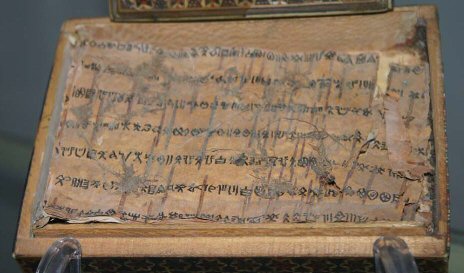
The 'Kabul Manuscript' currently residing in the
Sultani Museum in Kabul.
(Full
Report on the Kabul Manuscript).
3). It is proposed that the script didn't
exist before the arrival of the Spanish missionaries.
Response: The suggestion that Rongorongo didn't exist
before the arrival of the Spanish is speculative and the
evidence doesn't support this theory. Firstly, tradition states
that it arrived with the first settlers, and at least two of the surviving
tablets have a verified pre-Spanish origin
(1)
According to Thomson, Hotu-matua arrived on the island with 67
inscribed tablets or sticks (1889: 514). Though the number may
be exaggerated, there is no reason to attribute the origin of
the script to another source than that of the first settlers. If
the script was only invented after the visit of the Spanish ship
in the year 1770, as is maintained by S.R. Fischer (1997: 367),
the inventor of the script would certainly be known by his
historical name and there would be no need to replace it by a
legendary name like Tuu-ko-Iho. Moreover, there are no
similarities between the Easter Island script and the European,
as is admitted by Fischer (1997: 375). Above all it is not a
letter script and the Easter
Islanders confessed that they had little understanding of their
meaning since the elders were taken by 'Peruvian conquerors',
suggesting an origin of great antiquity.
|
Arguments
For a Connection: |
The original
findings in 1932 by Wilhelm de Hevesy suggested that as many as forty Rongorongo symbols had a
correlating symbol in the script from India. This number has now
risen through independent research, including the recognition of
similar variations of symbols in both scripts
(View
Here). The only visual
difference between the two scripts is that one is written in 'stick'
form, whereas the other is 'rounded' in form, which is not such an
unlikely development on an isolated island over a thousand year
period. It can be seen from the debate above that the Indus Valley
Culture were navigating the Australasian oceans at the same time
that the Pacific islands were first colonised, and that scripts,
especially those considered 'sacred' have an enduring nature.
A significant
recognition in relation to this subject is the observation
that within the remaining 26 examples of Rongorongo, similar
stretches of text have been found to be repeated on several of the
samples is suggestive of a ritual
record keeping, in the same way that the oral tradition recorded
origin myths, ancestral genealogies, or other important knowledge
such as astronomical cycles (Both of the last two are suspected
within the surviving Rongorongo samples). This repetition of script
leans in favour of the idea that the large number of Rongorongo
boards reported 'In every Hut' were likely reproductions (or
variations of earlier versions), no longer literally understood, but
used symbolically (or mnemonically), perhaps in the same way that Holy books
are kept in their home today.

(Extracted from Wikipedia May, 2013)
This set of
characters, extracted from the full set of Rongorongo glyphs
is said to account for over 90% of all the known texts.
Whilst the
traditional focus of attention in this debate is over the
implausibility of a connection between the Indus Valley Culture,
there have been several reports of ancient scripts that show
similarities to both Rongorongo and I.V.S, with suggestions that
they are all derived from a common, more ancient script as the
following examples demonstrate:
Comparison Between
Other Ancient Scripts and I.V.S / Rongorongo.
There are
several other samples of ancient script that have been shown to
have strong similarities with both I.V.S and Rongorongo as the
following examples show:
The 'Inga stone',
Brazil.
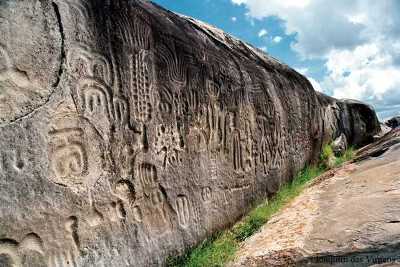
The Inga Stone in Brazil has several characters on
it which have been compared to Rongorongo.
Verill and Verill in
'Old Civilisations
of the New World' speak of inscriptions in the 'Indus-Gangetic'
script on a rock face 150 miles north of Cuzco, Peru, and another
one like it in another location in Peru: similar signs have been
found as grafitti on rock faces across Peru and even into Northern
Argentina according to the researches of Bernardo da Silva Ramos
(done for the Brazillian government but then denounced by the
government for what his findings implied: the book was printed at
private expense in 1939 as
'Inscripcioes e Traducioes da
America Prehistorica')
(8)
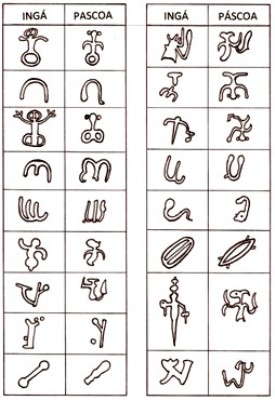
Comparison chart of Brazilian and Rongorongo.
Chinese Shang Script compared to I.V.S

Comparison between early Chinese Shang
script (rotated) and Indus Valley Script.
Photo Credits:
http://frontiers-of-anthropology.blogspot
The Sri-Lanka Stone Bench.
Discovered 3km off the coast of Godawaya, at the
site of a 2,000 year old shipwreck.
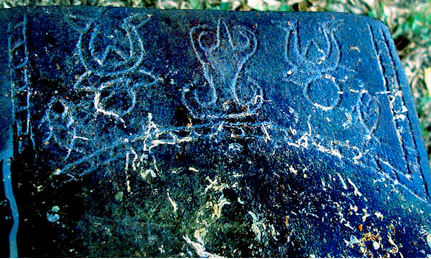

The Godawaya Inscription with identical
Rongorongo characters shown below.
It is noticeable
that the characters on the Godawaya Stone show closer similarity to
Rongorongo that I.V.S
(Ref:
www.academia.edu)
Gobekli
Tepe, Turkey.
 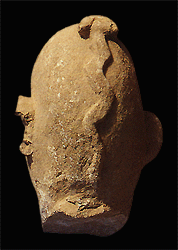
This 'tablet' (left)
was found at Gobekli Tepe, hinting at an earlier and more common origin to
the set of symbols seen in the I.V.S. The statue (right), also from
Gobkli Tepe is said perhaps coincidentally, to have strong
similarities to the Vedic style.
(More
about Gobekli Tepe, Turkey)
And Finally...
Palaeolithic Script:
Recent studies have
demonstrated that a common set of symbols existed as far back as the
Palaeolithic (12),, which can in turn be seen to have developed into
proto-alphabets in prehistoric cultures around the world. The
meanings of these earlier individual symbols can only be guessed at,
but their eventual adaptation into modern alphabets is now a
recognised fact. Many of the Palaeolithic characters (top row,
below) can be seen to share a similarity with both Indus Valley and
Rongorongo script.

In her Plato Prehistorian: 10,000 to 5,000 B.C.
Myth, Religion, Archaeology, Mary Settegast reproduces a table (above) which
shows four runic character sets; a is Upper Palaeolithic (found among
the cave paintings), b is Indus Valley script, c is Greek (western
branch), and d is the Scandinavian runic alphabet.
(More
about The Origin of Writing and Palaeolithic Script)
Conclusion:
Clearly, a
similarity between two scripts does not automatically mean that they
both originated from the same source. However, as can be seen from the
examples above, there is now sufficient evidence in favour of just
such a connection, and however frail that connection may seem it
continues to be the most likely solution to the remarkable similarities
between the Indus Valley and Easter island Scripts. Without another,
more plausible suggestion we are left with a limited number of
possibilities to explain such a connection. They are as follows:
(Rongorongo
- Corpus of Surviving Texts)
(Comparison
Chart - Indus Valley Script and
Rongorongo Characters).
(More
about Easter Island)
(More
about the Indus Valley Civilisation)
(The
Origin of Writing)
|











